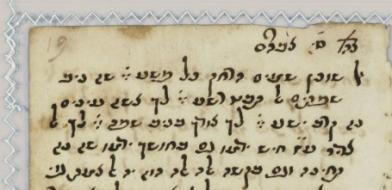A term used by Hassidim and East European hazzanim; it literally means 'Movement.' An ambiguous term, found in contemporary Hasssidic written and oral sources, and may have several, sometimes contradictory, meanings, that even the Hassidim themselves find hard to define. In most cases, the term refers to a short musical unit, fragment, or snippet, with characteristics that are difficult to define by known musical terms. Generally, but not always, it is to be distinguished from terms such as Kneytch, Fal, Niggun, and Nusah.[1]
Information about Tenu'a through oral traditions relates to only five dynasties: Vishnits, Koson, Chabad, Boyan, and Karlin. Of the rest nothing is known. In the Vizhnitz and the Koson dynasties, the Rebbe is the performer and the number of tenu’ot is limited. They are mostly sung before performing a mitsvah or a special prayer. Some see this as a form of preparation, while others explain it as a means for filling an otherwise empty space.
Among the Vizhnitzer hassidim, four tenu’ot can be found: one is sung on the Sabbath eve before the kiddush and on Hannuka, before the lighting of the candles; a second one is sung before the Passover Seder and before the Leshem Yihud prayer of the Sefirat Ha’omer. It is also sung between sections of the Passover haggada and between the different parts of the Sefirat Ha’omer. The last two tenu’ot take place on the Sabbath: the third during the 'Arvit (evening) prayer before the Silent Amidah, and the fourth before the Mussaf Amidah prayer.
Koson hassidim have three tenu’ot: One is sung on Sabbath eve before and after the kiddush; the second is during the Sabbath mussaf before the Silent Amidah; and the third is during the Passover haggada between the Hallel Psalms. One of the pan-hassidic synagogues in Jerusalem, in the Batei Verner neighborhood, used to sing in the 50's and the 60's a tenu’a before saying the blessing for the new month.
The Chabad tradition is totally different: on the one hand each hassid can freely choose, while praying, any tenu’a that may help him reach a deeper, more elevated, state of devekut.[2] On the other hand, one of the most important niggunim of the Chabad repertoire is the “three tenu’ot niggun” (sound example) which was created, as tradition has it, by the three leaders of hassidism: its founder, the Baal Shem Tov (“Besht”); his student and heir to the leadership, the Maggid (Rabbi Dov Ber of Mezritch); and Rabbi Shneur Zalman of Liadi (“The Reshaz”), founder of the Chabad movement.[3] This Niggun is not connected to a specific event or date. However, in significant Chabad gatherings (Hitva'aduyot), the Hassidim sing a medley of niggunim ('seder niggunim'), each of which is associated with a different Tzadik of the dynasty. This medley always begins with 'three tenu’ot niggun.'
The Boyan and the Karlin hassidim know of the concept, but do not actually have tunes under that name.
[1] See for example: Wertheim, pp. 105-6.
[2] See Wertheim, Ibid.
[3] Zalmanov, Ibid, and informants.





